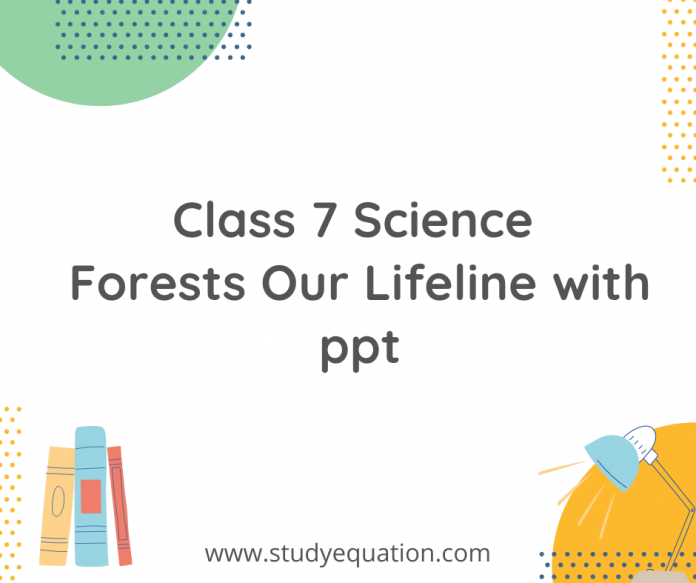NCERT Solutions for forest our lifeline class 7 ppt, here we are going to give you a summary of NCERT Solutions Class 7 Science Forests Our Lifeline with questions and answers and winds storms and cyclones class 7 ppt from the textbook. In this chapter we will study the different terms regarding forests, food chain and importance of forests. Your all doubts from the chapter of forest our lifeline ppt class 7 NCERT will be cleared from this explanations. Here you will get the summary of the chapter and also get the Notes and PDF’s of forests our lifeline class 7 science chapter 18.
Read more: Ncert solutions for class 7 science chapter 8 Winds, Storms and Cyclones
Table of Contents
NCERT Solutions Class 7 Science Forests Our Lifeline
Introduction
Forests are a renewable source. They contribute substantially to economic development. They play a major role in cutting off pollution. The forests are economically important to every country.
Here is the NCERT Solutions for Class 7 Science Forests Our Lifeline from the chapter and visit of Paheli and Boojho, their friends and Professor Ahmad from the forest.
Important Words Regarding Forest Our Lifeline ppt class 7 science.
Crown of the tree: Branchy part of a tree above the stem is known as the crown of the tree.

Canopy: When the branches of the tall trees look like a roof over the other plants in the forest, it is called a canopy.
Understoreys: trees had crowns of different types and sizes. These had created different horizontal layers in the forest. These are known as understoreys. Giant and tall trees constituted the top layer followed by shrubs and tall grasses, and herbs formed the lowest layer.
Humus: The dead plant and animal tissues and convert them into a dark coloured substance called humus.
Decomposers: The micro-organisms which convert the dead plants and animals to humus are known as decomposers.
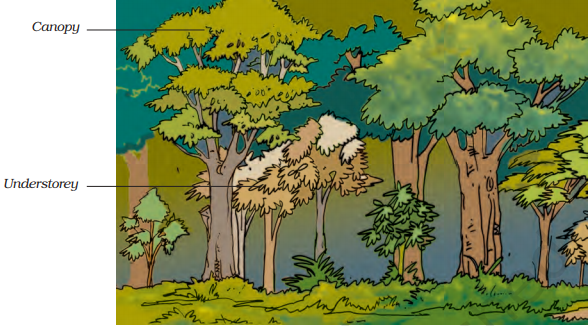
Why do we not see similar kind kind of trees in every forest?
We do not see similar kind of trees in every forest due to different climatic conditions. There are variations in the types of trees and other plants. The types of animals also differ from forest to forest.
Food Chain
All animals, whether herbivores or carnivores,depend ultimately on plants for food. Organisms which feed on plants often get eaten by other organisms, and so on.
One eg. of food chain is:
Grass→ insects→ frog→ snake→ eagle
In forests many food chains are found. All food chains are linked. If any one food chain is disturbed, it affects other food chains. .
Every part of the forest is dependent on the other parts. If we remove one component, say trees, all other components would be affected.
Q.1. What do mushroom and other microorganisms eat?
Q.2. What is the importance of forest in our life class 7?
Q.3. Who is crucial to maintaining the forest for Class 7?
Q.4. Why is the forest vital to life?
Nutrients Recycled
Nothing goes waste in a forest.
The presence of humus ensures that the nutrients of the dead plants and animals are released into the soil.
These nutrients are again absorbed by the roots of the living plants.
Animals get food from these plants, or from animals who eat these plants.
If an animal dies in the forest they become food for vultures, crows, jackals and insects.
Nutrients are cycle takes place.
Forests are called Green Lungs.
Plants release oxygen through the process of photosynthesis.
The plants help to provide oxygen for animal respiration.
They also maintain the balance of oxygen and carbon dioxide in the atmosphere
Also, trees take in water from their roots and release water vapour into the air through evaporation.
That is why forests are called green lungs.
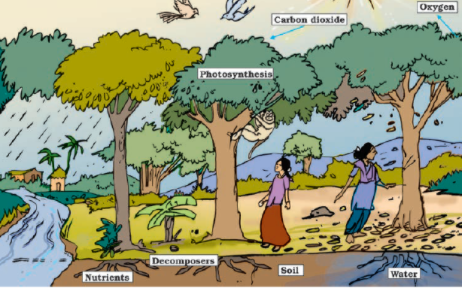
People And Forest.
Many people also live in the forest. Some of them may belong to different tribes.
The forest provides them with food, shelter, water and medicines. They have traditional knowledge about many medicinal plants in the forest.
Importance Of Animal Dropping
The forest officers can recognise the presence of some animals in the forest by their droppings and footprints.
The animals also disperse the seeds of certain plants and help the forest to grow and regenerate.
The decaying animal dung also provides nutrients to the seedlings to grow.
NOTE: By harbouring a greater variety of plants, the forest provides greater opportunities for food and habitat for the herbivores. Larger number of herbivores means increased availability of food for a variety of carnivores. The wide variety of animals helps the forest to regenerate and grow. Decomposers help in maintaining the supply of nutrients to the growing plants in the forest. Therefore, the forest is a ‘dynamic living entity’ — full of life and vitality.
Heavy Rain Does Not Affect Forest
Forest also acts as a natural absorber of rainwater and allows it to seep.
It helps maintain the water table throughout the year. Forests not only help in controlling floods but also help maintain the flow of water in the streams so that we get a steady supply of water.
What would happen if trees are not present?
Rain hits the ground directly and may flood the area around it. Heavy rain may also damages the soil. Roots of trees normally bind the soil together. In their absence the soil is washed away or eroded.
Noise pollution, is less because the forest absorbs the noise.
Importance of Forest Our Lifeline Class 7 ppt NCERT solutions
- Forests provide us with oxygen.
- They protect soil.
- Provide habitat to a large number of animals.
- Forests help in bringing good rainfall in neighboring areas.
- They are a source of medicinal plants, timber and many other useful products.
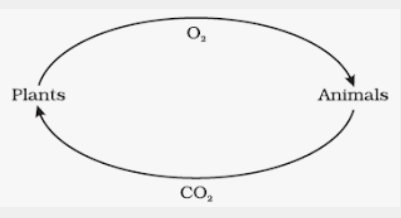
What Will Happen If Forest Disappears?
- If forest disappear, the amount of carbon dioxide in air will increase, resulting in the increase of earth’s temperature.
- In the absence of trees and plants, the animals will not get food and shelter.
- In the absence of trees, the soil will not hold water, which will cause floods.
- Deforestation will endanger our life and environment.
Let us now proceed to Exercises: NCERT Solutions for Class 7 Science Forests Our Lifeline.
Exercises of Class 7 Science Forest Our Lifeline ppt(NCERT solutions)
1. Explain how animals dwelling in the forest help it grow and regenerate.
Ans. animals dwelling in the forest help it grow and regenerate by:
- They eat the vegetation.
- They help in seed dispersal.
- Their pouring helps in growth of plants.
- Dead remains of animals make humus after decomposition by the microorganisms and it increases soil fertility.
2. Explain how forests prevent floods.
Ans. Forest also acts as a natural absorber of rainwater and allows it to seep.
It helps maintain the water table throughout the year. Forests not only help in controlling floods but also help maintain the flow of water in the streams so that we get a steady supply of water.
3. What are decomposers? Name any two of them. What do they do in the forest?
Ans. Decomposers are the micro-organisms which convert the dead plants and animals to humus.
4. Explain the role of forest in maintaining the balance between oxygen and carbon dioxide in the atmosphere.
Ans. Plants in forest release oxygen through the process of photosynthesis.
The plants help to provide oxygen for animal respiration.
This is how they maintain the balance of oxygen and carbon dioxide in the atmosphere.
5. Explain why there is no waste in a forest.
Ans. The presence of humus ensures that the nutrients of the dead plants and animals are released into the soil.
Roots of the living plants thus absorb these nutrients again.
Animals get food from these plants, or from animals who eat these plants.
If an animal dies in the forest they become food for vultures, crows, jackals and insects.
Nutrient cycle thus takes place. And thus there is no waste in a forest.
6. List five products we get from forests?
Ans. Five products we get from forests:
- Latex of the rubber tree
- Oil
- Timber
- Honey
- Medicines
7. Fill in the blanks:
(a) The insects, butterflies, honeybees and birds help flowering plants in __________.
(b) A forest is a purifier of __________ and __________.
(c) Herbs form the __________ layer in the forest.
(d) The decaying leaves and animal droppings in a forest enrich the __________.
Ans. (a) Pollination (b) Water and air (c) Understory (d) Topsoil
8. Why should we worry about the conditions and issues related to forests far from us?
Ans. Forests maintain the oxygen-carbon dioxide balance, reduces noise pollution, gives us a number of useful things, helps in floods, and many more. Thus if we ignore conditions and issues related to forests far from us we will lose all these things. So we should not ignore these.
9. Explain why there is a need for a variety of animals and plants in a forest.
Ans. All animals, whether herbivores or carnivores, depend ultimately on plants for food. Organisms which feed on plants often get eaten by other organisms, and so on.
This is said to form a food chain: All food chains are linked. Other food chain are affected, if any one food chain is disturbed. Thus, there is a need for a variety of animals and plants in a forest.
10. In Fig. below, the artist has forgotten to put the labels and directions on the arrows.
Mark the directions on the arrows and label the diagram using the following labels: clouds, rain, atmosphere, carbon dioxide, oxygen, plants, animals, soil, roots, water table.
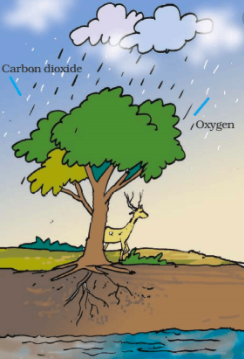
Ans.
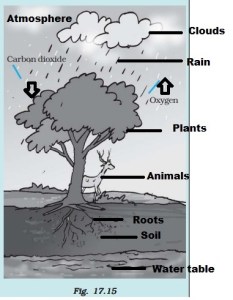
11. Which of the following is not a forest product?
(i) Gum (ii) Plywood (iii) Sealing wax (iv) Kerosene
Ans. (iv) Kerosene
12. Which of the following statements is not correct?
(i) Forests protect the soil from erosion.
(ii) Plants and animals in a forest are not dependent on one another.
(iii) Forests influence the climate and water cycle.
(iv) Soil helps forests to grow and regenerate.
Ans. (ii) Plants and animals in a forest are not dependent on one another
13. Microorganisms act upon the dead plants to produce
(i) sand (ii) mushrooms (iii) humus (iv) wood
Ans. (iii) humus
NCERT Solutions Class 7 Science Forests Our Lifeline : Conclusion
Thus, the value of forests may be understood from the forest our lifeline ppt. Forests provide us important products. All organisms lives depend on forests and thus we must discover mechanisms to manage the forest for all the benefits it can provide, in a sustainable manner. Forests give us life we should let it live too.
Download PPT On Forest Our Lifeline
You guys can access ppt on your favorite topic which actually belong from class 7 of NCERT books. To access ppt click on “Forest Our Lifeline – PPT“

